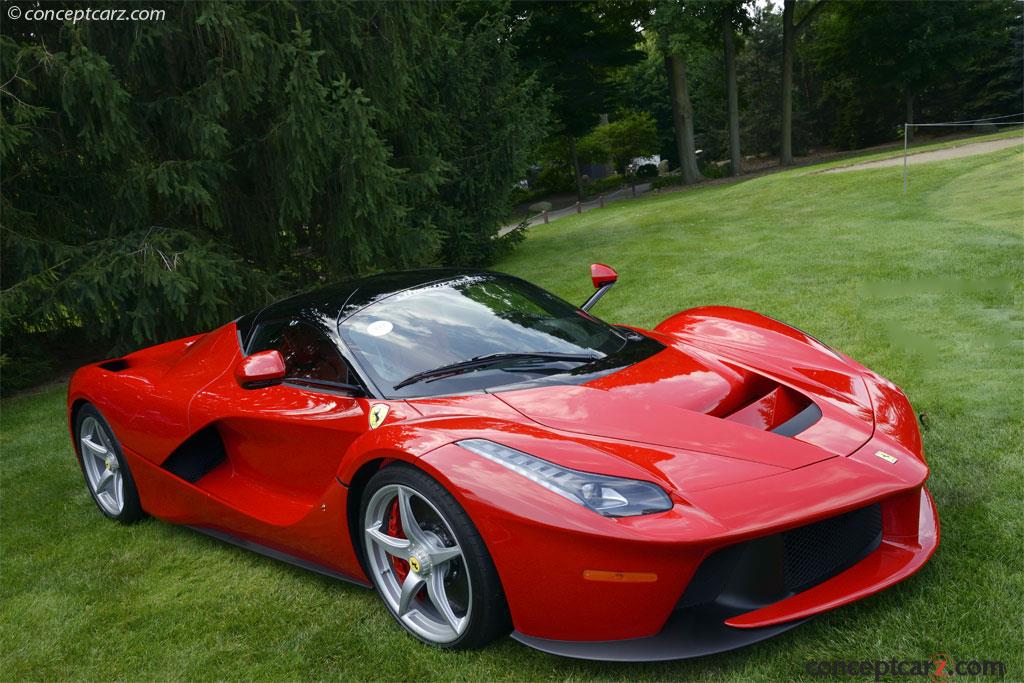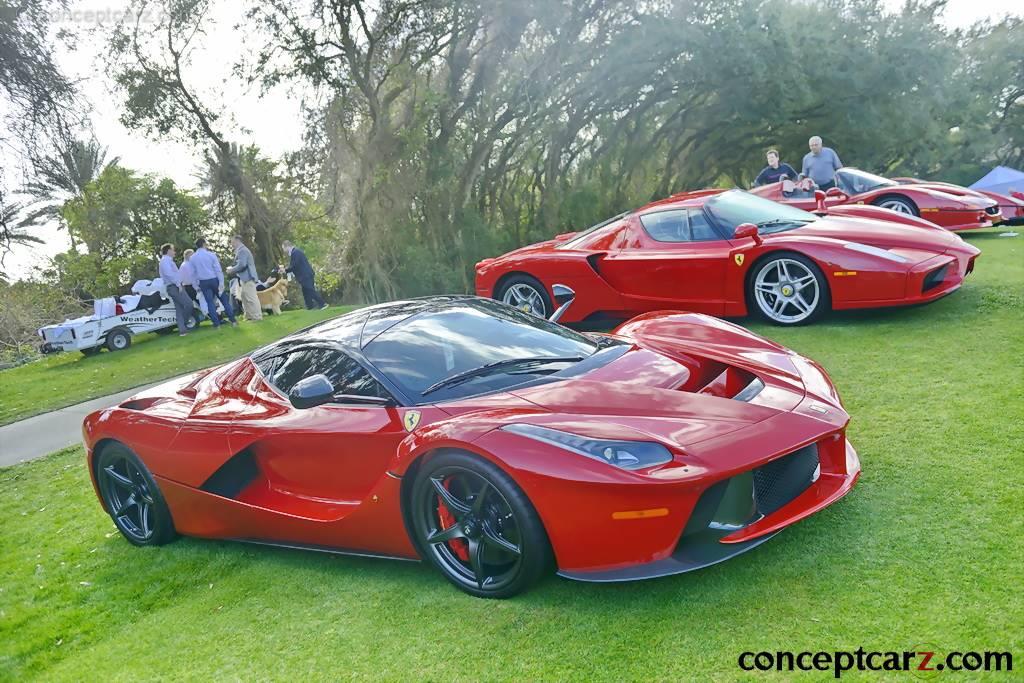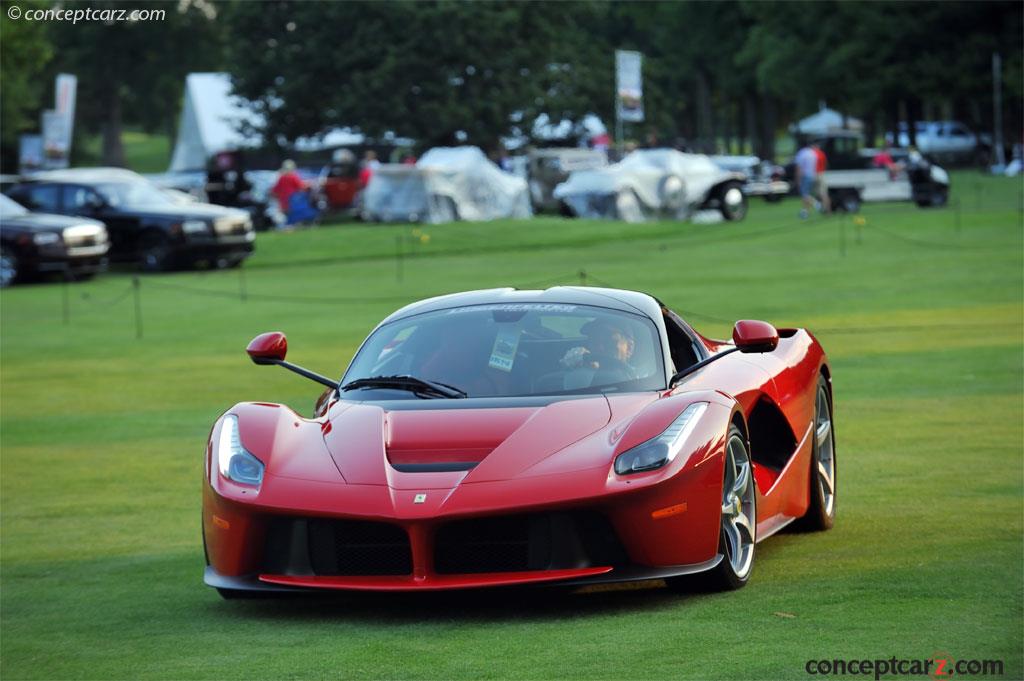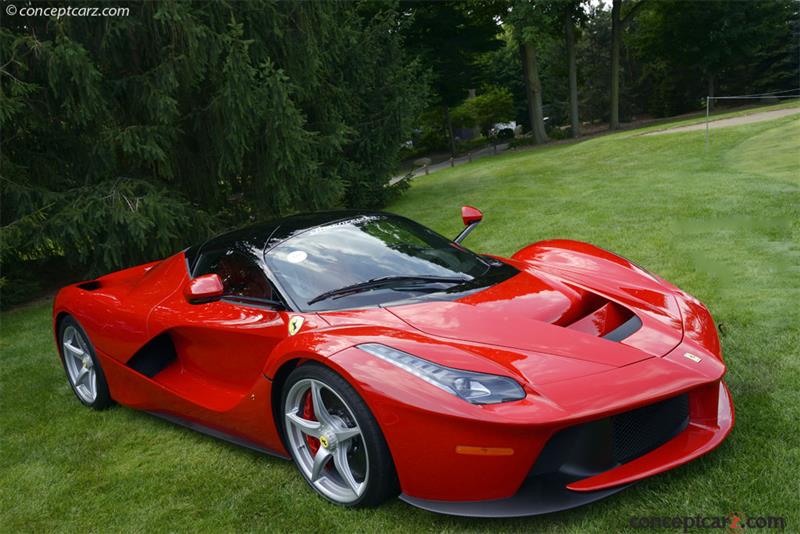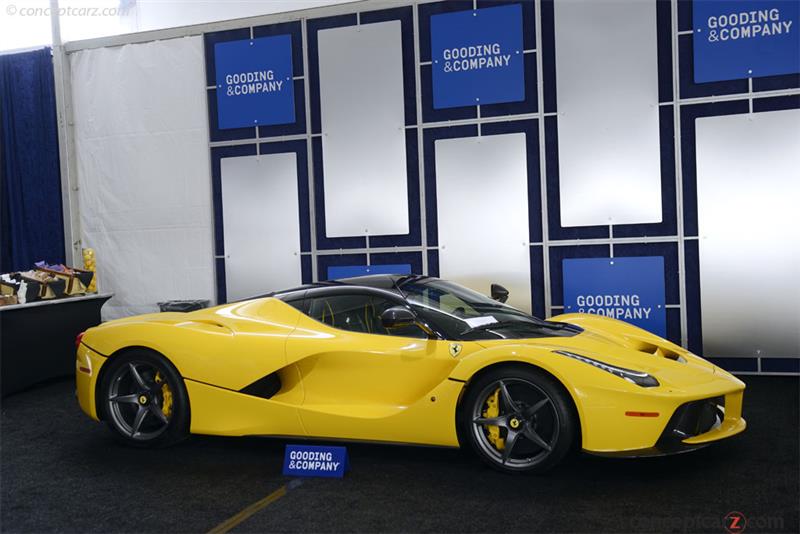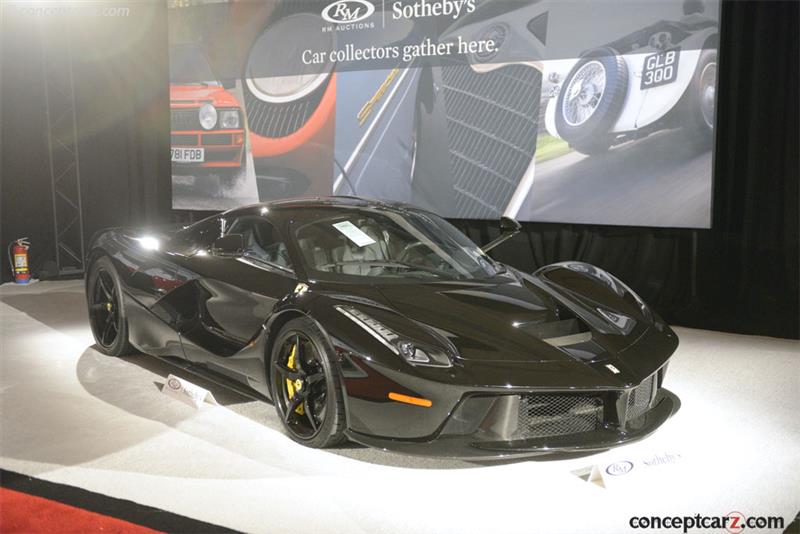The LaFerrari needs few superlatives. It is Ferrari's most ambitious project yet, pushing the boundaries of technology for a road car. It gathers together the marque's greatest technical capabilities from both GT and Formula 1 engineering, delivering the highest performance ever reached by a production Ferrari. And yet, the cause is noble. All this advanced technology will filter to the rest of the Ferrari model range.
Coupe
Chassis #: ZFF76ZFA9F0211998
View info and history
Auction entries : 1As Ferrari's first production car powered by the F1-derived HY-KERS hybrid drivetrain, it combines a 161-hp electric motor with the most powerful Ferrari V12, itself making 788 hp at 9000 rpm, for a power sum of 949 hp and 663 lb-ft of torque.
Striking proportions Cutting-edge details
The LaFerrari's silhouette and proportions are a natural product of its architecture with hybrid running gear, yet it still echoes the classic mid-rear-engine sports car archetype. Both the drivetrain and cockpit masses stay within the wheelbase to achieve the best possible balance, visually and dynamically.
LaFerrari's BODYWORK
Despite having the KERS system and the related batteries, plus numerous electronic components, the LaFerrari is no larger than the Enzo. Actually, the LaFerrari's front and rear overhangs are better balanced due to packaging the complex powertrain. And when viewed from the front and sides, a sharply downward-sloping nose emphasizes the muscular fenders, echoing the glorious Ferrari sports prototypes on the late 1960s and early 1970s like the 330 P4 and the 312P.Entirely new concept
The LaFerrari's driving position draws heavily from F1 influence, with Scuderia drivers directly involved in design and development. The cockpit clearly shows its motorsports origins, yet marries tradition and modernity. The driving position turns normal road-car conventions on their head. The seat is fixed in position. Both the steering wheel and pedal box adjust to meet the driver's hands and feet.LaFerrari's CABIN
The steering wheel shows in-depth research and development tied to motorsports with the LaFerrari's various functions integrated in Formula 1 fashion. Designers lengthened the gear-shift paddles, making them more ergonomic. The gearbox control's bridge in the center of the cockpit takes on a suspended wing shape. Lastly, the instrument panel's secondary controls for audio, navigation, climate and telemetry are located on the door and the center of the dashboard, highlighting the mission-critical controls directly in front of the driver.
Coupe
Chassis #: ZFF76ZFA1F0209257
View info and history
Auction entries : 1A reconfigurable digital instrument panel gives the choice of a traditional central tachometer or a more competition-derived display.HY-KERS BLENDS BLISTERING PERFORMANCE AND MAXIMUM EFFICIENCY.Pushing the boundaries of technology and performance from a road car, the LaFerrari embodies the best of GT and Formula 1 engineering for the street. Delivering the highest performance ever achieved by a Ferrari production car, it uses technology that will filter into the rest of the Ferrari range in the future. HY-KERS BLENDS BLISTERING PERFORMANCE AND MAXIMUM EFFICIENCY.Pushing the boundaries of technology and performance from a road car, the LaFerrari embodies the best of GT and Formula 1 engineering for the street. Delivering the highest performance ever achieved by a Ferrari production car, it uses technology that will filter into the rest of the Ferrari range in the future. HYBRID DRIVETRAIN: A MARRIAGE MADE FOR POWER.The LaFerrari is the first production car to emerge from Maranello with a hybrid drivetrain. The 6.3-liter V12 produces 788 hp, while the electric motor adds another 161 hp for a sum of 949 total hp.
Coupe
Chassis #: ZFF76ZFA4F0211245
View info and history
Auction entries : 1 It makes full use of Ferrari's KERS (Kinetic Energy Recovery System) expertise in F1, integrating the two power sources seamlessly and with maximum efficiency. The electric motor's strong low-speed torque allowed high-rpm freedom for the internal combustion V12, creating an unending surge of power throughout all speeds and a torque peak of over 663 lb-ft.DENSELY-PACKED POWER UNIT, LOW CENTER OF GRAVITY.Together as a power unit, the overall dimensions of the internal combustion V12, F1 dual-clutch gearbox and electric motor are surprisingly compact. Engineers also replaced the alternator with an auxiliary electric motor, which not only helps compactness, it also removes weight. Always looking ahead, Ferrari implemented the HY-KERS architecture to be flexible and modular for future application in other models.The power unit's electric motor is designed with high specific power density, enabling engineers to drastically reduce weight and space in relation to available torque. Performance figures compare to an F1 car with the same torque density and efficiency (94%). Battery size is critical to maintaining the HY-KERS power-to-weight ratio. An extremely complex assembly of 120 cells fitting into eight modules generate the equivalent of 40 traditional batteries, yet weigh merely 132 pounds. Capitalizing on in-house talent, Scuderia Ferrari manufactures the high-voltage batteries. While driving, the batteries are charged under braking - even hard braking when anti-lock is triggered as when on a racetrack - and every moment the V12 produces more torque than required, as when cornering. Rather than the being sent to the wheels, this excess torque is converted to energy and stored in the batteries. The HY-KERS system is governed by the Hybrid Power Unit. This controls power delivery from both the V12 and the electric motor through two inverters and two DC-to-DC converters. Variable-frequency control makes torque delivery rapid and precise, improving performance. Carbon dioxide emissions are a low 531 grams per mile without resorting to pure electric drive, the latter being a character not at all in line with the LaFerrari. The HY-KERS system itself, however, can be engineered for other vehicles in future applications to run on pure electric drive.
THE MOST POWERFUL NATURALLY-ASPIRATED ENGINE EVER IN FERRARI A ROAD CAR.
Coupe
Chassis #: ZFF76ZFA2F0211079
View info and history
Auction entries : 1While it produces 788 hp, the LaFerrari V12 spins all the way to 9250 rpm, giving fantastic performance plus an unmistakable Ferrari V12 song. Such high rpms are the results of volumetric, mechanical and combustion efficiencies. Continuously variable-length intake tracts improved volumetric efficiency and performance. This had been a practice perfected in F1 engine technology until rule changes banned its use.Total torque generated by the whole power unit is over 663 lb-ft. Instantaneous torque from the electric motor at lower revs make for neck-snapping operation while the V12 engine's power delivers an abundance at high revs. The V12's solo peak torque of 516 lb-ft actually arrives at 6750 rpm. From the dynamic air intakes to the intake plenum, the engine's breathing apparatus maximizes intake volume efficiency. The engine also squeezes the most out of every droplet of fuel with a lofty 13.5:1 compression ratio.
Coupe
Chassis #: ZFF76ZFA9F0211998
View info and history
Auction entries : 1
A very light, yet strong crankshaft spins in the crankcase. Close attention netted highly aerodynamic counterweights to minimize pumping losses and windage at high rpms. This crankshaft also benefits from low rotational mass, cut by 19 percent from other V12s in the Ferrari range.
Ferraris must sound special and the LaFerrari breaks new ground sonically. Careful tuning of the exhaust with equal-length, 6-into-1 manifolds help deliver an unmistakable, high-pitched Ferrari soundtrack made even higher due to the additional revs at the top end.
Coupe
Chassis #: ZFF76ZFA9F0211998
View info and history
Auction entries : 1 The system was hydroformed using Inconel - as Ferrari does in F1 - to keep weight low. Inconel is also very resistant to high temperatures.DESIGN PROCESS THAT FOLLOWS THE FORMULA 1 EXAMPLE.Ferrari draws on the Scuderia's F1 experience in materials choice, design, engineering and small-capacity manufacturing, but the teamwork doesn't stop there. Rory Byrne, the legendary F1 designer who conceived 11 Ferrari World Championship-winning cars became a key technical and design consultant. A working group of GT and F1 engineers first designed a chassis to give the maximum rigidity in all dimensions with minimum weight. Several non-traditional decisions were made early on, including the incorporation of the seat structure as part of the chassis. This reduces weight, enables a more compact architecture and lowers the center of gravity.With these cutting-edge processes, the engineering team betters the Enzo's already rigid platform by 27 percent, beam stiffness by 22 percent and lowers weight by 20 percent. The chassis is built entirely in-house in Maranello alongside the F1 single-seaters using the Scuderia's materials and production.THE FOUR CARBON-FIBERS, ALL FOR DIFFERENT MISSIONS.All carbon-fiber is not created equal and the LaFerrari uses four different types of it for areas of the car with differing missions. The LaFerrari is the first automobile to use a tub made from T800 carbon-fiber. The manufacturing process includes hand-laying sheets of the mesh material to ensure accuracy and quality. Areas critical to passenger protection such as doors sills use T1000 fabric mesh that offers high energy absorption to surpass the strictest side-impact regulations. Structural body elements use another variation of carbon-fiber, M46J, which is extremely rigid, but even lighter. For the underbody, carbon-fiber is joined by Kevlar® to protect the car's structure from road debris and damage. This multi-material approach actually reduces the number of components and lowers weight. For example, the one-piece rear section is laid up by hand using a combination of M46J and T800 carbon-fiber sheets before being heated. This creates a very lightweight, yet rigid structure. All of the LaFerrari's carbon-fiber is cured in the F1 chassis autoclaves in two phases between 266°F and 302°F using vacuum bags to remove any voids in the laminate.ArchitectureA PINNACLE, EVEN BY FERRARI STANDARDS.The LaFerrari architecture had four objectives: maximize aerodynamic efficiency; deliver ideal weight distribution; achieve the lowest possible center of gravity; and, most importantly, seamlessly integrate the new hybrid power unit. The LaFerrari succeeds on all counts and does so without restricting cabin space, reducing comfort or limiting accessibility.WEIGHT CARRIED LOW IS ITS OWN REWARD.Compared to the Enzo, the LaFerrari's center of gravity is 1.3-in. lower. Also, weight distribution (41-percent front / 59-percent rear) differs from the Enzo with major masses fully inside the wheelbase, helping create a low polar moment of inertia. This aids stability, predictability and grip in all driving conditions.One of the LaFerrari's greatest challenges is incorporating the hybrid drive system. Despite having the same wheelbase and overall length as the Enzo, the LaFerrari packages its V12 engine, hybrid system, F1 dual-clutch gearbox plus all their cooling systems. Put another way, meticulous, clever engineering and design fits the running gear of two cars in the engine space of one. The LaFerrari driver is laid back more than in the Enzo and more than in other current production Ferrari models. There's a greater rake to the body, making the LaFerrari a meeting point between sports car and F1 single-seater driving positions. The seat itself is part of the chassis and not bolted into place, improving sensitivity to vehicle dynamics. While the seat is fixed inlace, the pedal box adjusts completely. Similarly, the steering wheel adjusts for reach and height.AerodynamicsFERRARI F1 WIND TUNNEL RESEARCH.The challenge aerodynamically was to deliver the best aerodynamic efficiency ever achieved by any road car. Through computer modeling at first and subsequent F1 wind tunnel testing, engineers achieved a record level of aero efficiency.THE PERFECT BALANCE OF FORM AND FUNCTION.What makes the LaFerrari concept so innovative is the use of active aerodynamics as a tool for the car's other dynamic control systems, delivering a breakthrough in overall performance not possible if both were independent. Integration of active aero with the dynamic controls and systems make even better use of the downforce and aero balance gains. The LaFerrari has an extremely compact frontal area for low drag and the greenhouse shape helps airflow reach the rear air cooling intakes. The front wing creates downforce by eliminating pitch sensitivity caused by the pronounced splitters. A broad central air vent on the front hood extracts hot air from the radiator. Finally, the front spoiler also generates downforce. A central flap helps keep the air escaping from the vent close to the bodywork to reduce wake turbulence, while the rear radius of the vent reduces drag.A scallop behind the front fenders boosts air extraction from around the wheels and improves front diffuser efficiency as well as increasing downforce. The airflow then descends and is channelled by the doors to the rear radiators. The two engine air intakes atop the rear fenders provide a ram effect, which increases power by about 4 hp. The underbody aerodynamics change as the active rear spoiler is deployed:
• flaps at the rear diffuser rise to increase expansion and therefore air extraction• flaps at the front diffuser rise to increase expansion and downforce to match, and balance with the rear• at high speeds, the guide vane at the front underbody directs excess air away from the front radiator, reducing drag
Source - Ferrari
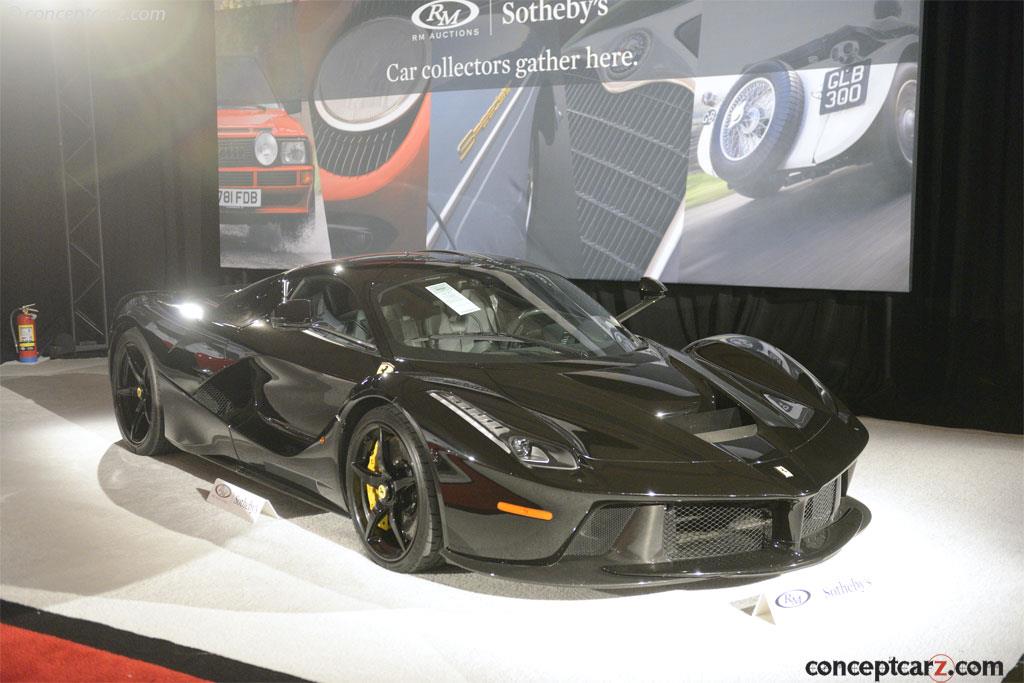
Coupe
Chassis #: ZFF76ZFA9F0211998
View info and history
Auction entries : 1
Striking proportions Cutting-edge details
The LaFerrari's silhouette and proportions are a natural product of its architecture with hybrid running gear, yet it still echoes the classic mid-rear-engine sports car archetype. Both the drivetrain and cockpit masses stay within the wheelbase to achieve the best possible balance, visually and dynamically.
LaFerrari's BODYWORK
Despite having the KERS system and the related batteries, plus numerous electronic components, the LaFerrari is no larger than the Enzo. Actually, the LaFerrari's front and rear overhangs are better balanced due to packaging the complex powertrain. And when viewed from the front and sides, a sharply downward-sloping nose emphasizes the muscular fenders, echoing the glorious Ferrari sports prototypes on the late 1960s and early 1970s like the 330 P4 and the 312P.Entirely new concept
The LaFerrari's driving position draws heavily from F1 influence, with Scuderia drivers directly involved in design and development. The cockpit clearly shows its motorsports origins, yet marries tradition and modernity. The driving position turns normal road-car conventions on their head. The seat is fixed in position. Both the steering wheel and pedal box adjust to meet the driver's hands and feet.LaFerrari's CABIN
The steering wheel shows in-depth research and development tied to motorsports with the LaFerrari's various functions integrated in Formula 1 fashion. Designers lengthened the gear-shift paddles, making them more ergonomic. The gearbox control's bridge in the center of the cockpit takes on a suspended wing shape. Lastly, the instrument panel's secondary controls for audio, navigation, climate and telemetry are located on the door and the center of the dashboard, highlighting the mission-critical controls directly in front of the driver.
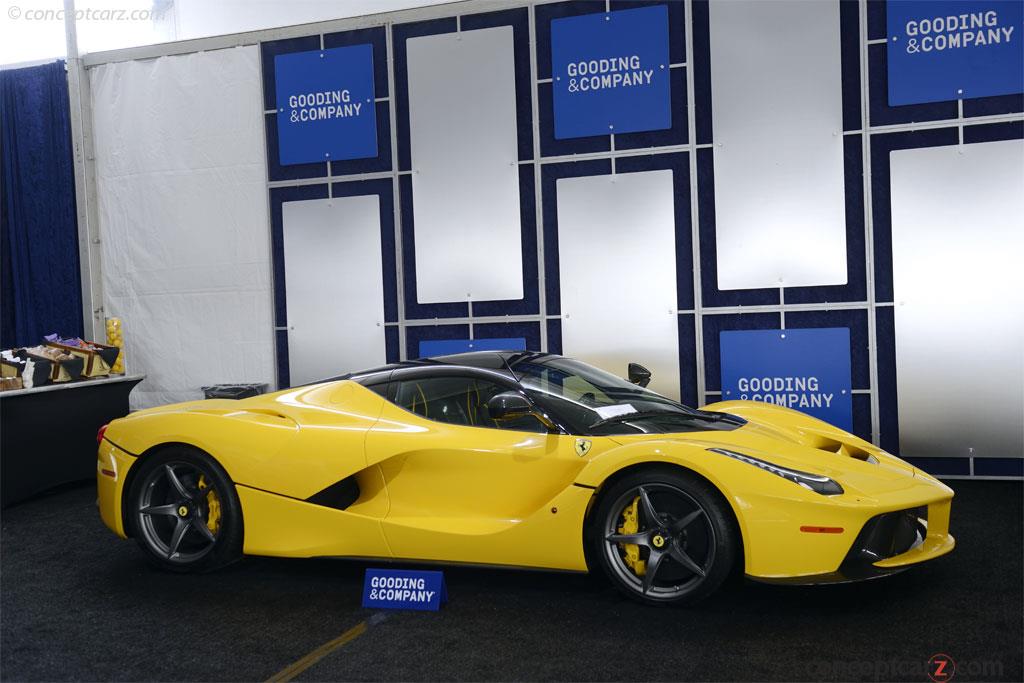
Coupe
Chassis #: ZFF76ZFA1F0209257
View info and history
Auction entries : 1
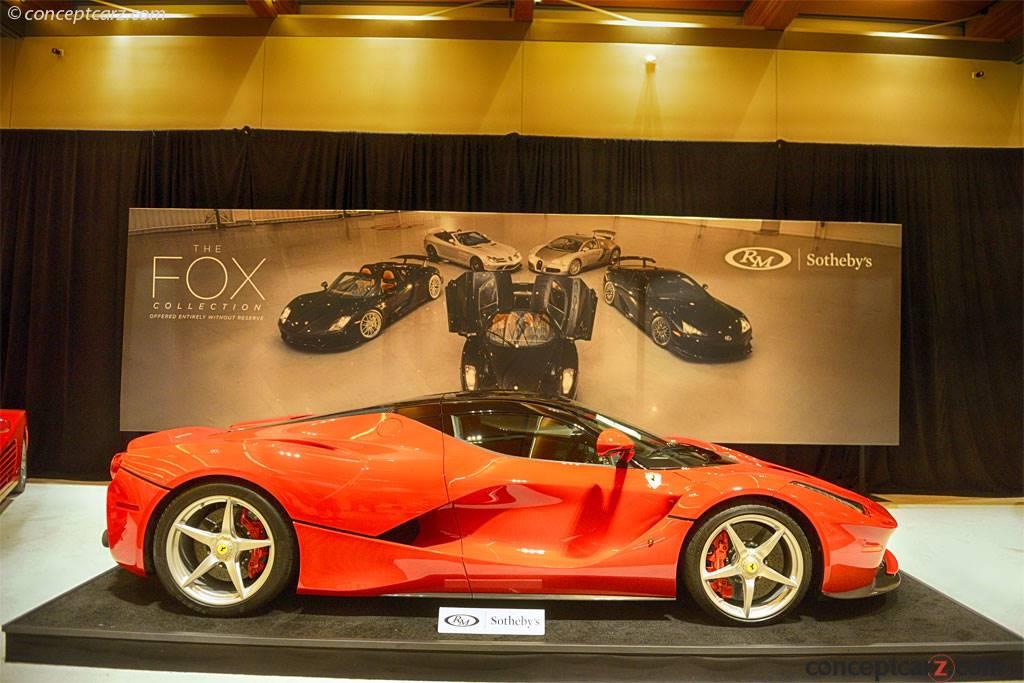
Coupe
Chassis #: ZFF76ZFA4F0211245
View info and history
Auction entries : 1
THE MOST POWERFUL NATURALLY-ASPIRATED ENGINE EVER IN FERRARI A ROAD CAR.
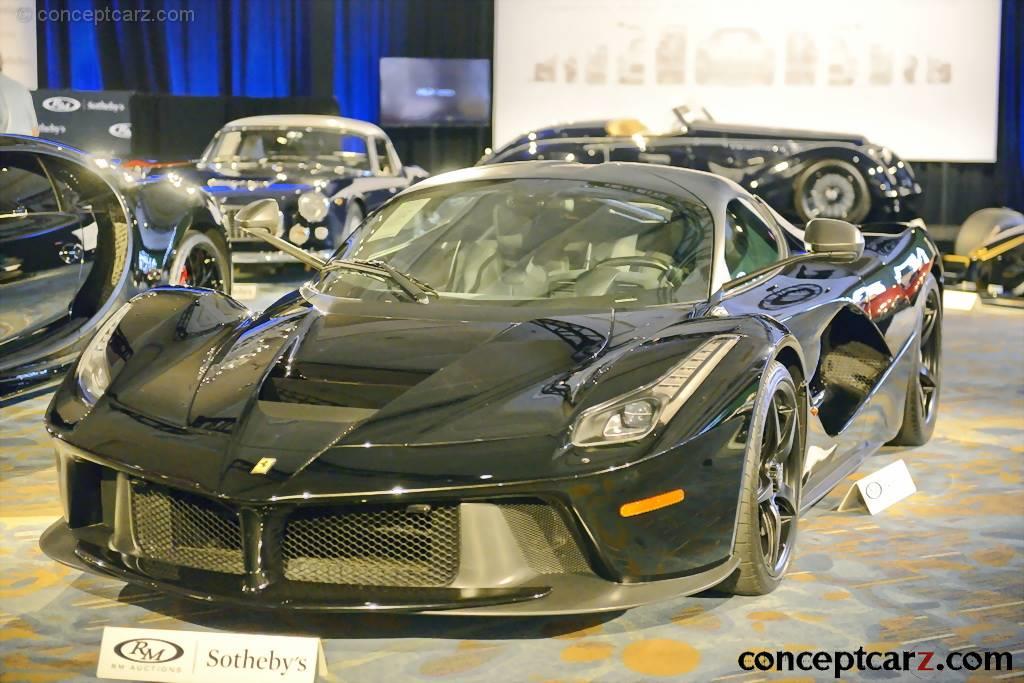
Coupe
Chassis #: ZFF76ZFA2F0211079
View info and history
Auction entries : 1
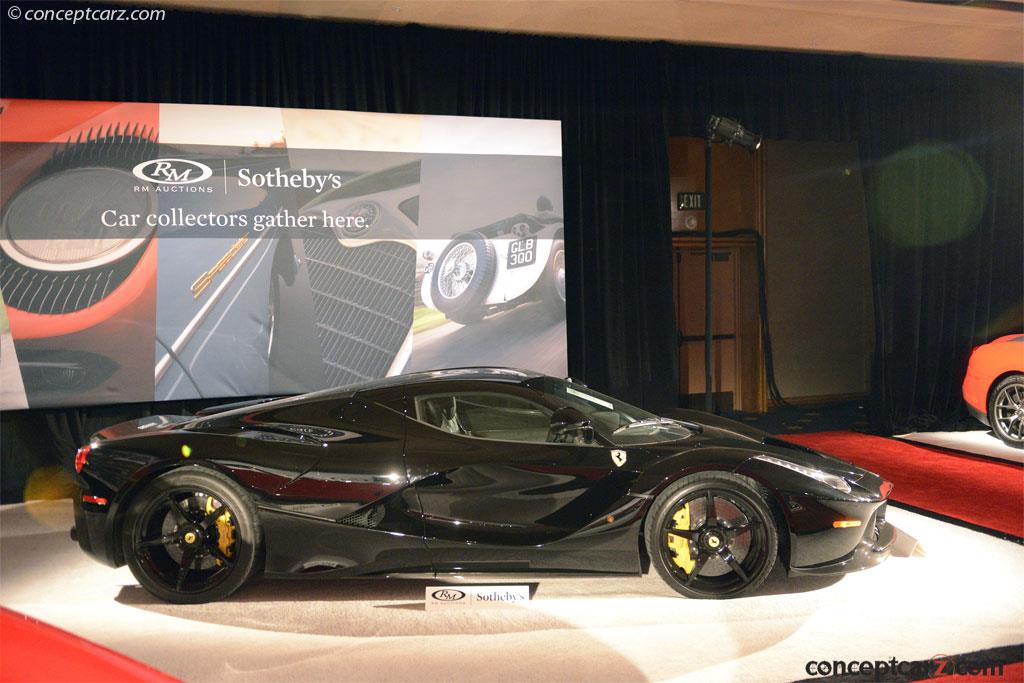
Coupe
Chassis #: ZFF76ZFA9F0211998
View info and history
Auction entries : 1
A very light, yet strong crankshaft spins in the crankcase. Close attention netted highly aerodynamic counterweights to minimize pumping losses and windage at high rpms. This crankshaft also benefits from low rotational mass, cut by 19 percent from other V12s in the Ferrari range.
Ferraris must sound special and the LaFerrari breaks new ground sonically. Careful tuning of the exhaust with equal-length, 6-into-1 manifolds help deliver an unmistakable, high-pitched Ferrari soundtrack made even higher due to the additional revs at the top end.
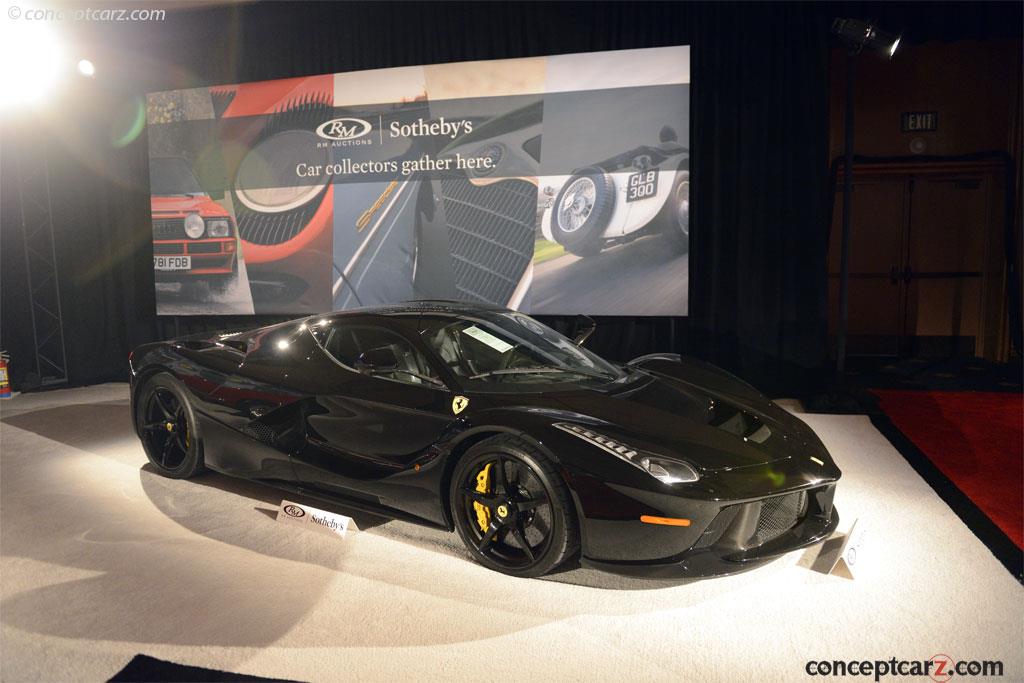
Coupe
Chassis #: ZFF76ZFA9F0211998
View info and history
Auction entries : 1
• flaps at the rear diffuser rise to increase expansion and therefore air extraction• flaps at the front diffuser rise to increase expansion and downforce to match, and balance with the rear• at high speeds, the guide vane at the front underbody directs excess air away from the front radiator, reducing drag
Source - Ferrari
Similar Automakers
2015 Ferrari LaFerrari Vehicle Profiles
Recent Vehicle Additions
Performance and Specification Comparison
Related Automotive News

World's Most Coveted Supercars, Including Sammy Hagar's 2015 Ferrari LaFerrari, 2018 Bugatti Chiron and 2015 Porsche 918 Spyder, Headed to Barrett-Jackson's Scottsdale Auction
Barrett-Jackson, The Worlds Greatest Collector Car Auctions, will offer some of the worlds most coveted supercars during the 2024 Scottsdale Auction, held January 20-28, 2024. Each of these supercars are masterpieces of automotive engineering, design...

Electrified And Upgraded Ford Fiesta – Even Better Fuel Economy, More Fun To Drive And More Technology
Ford introduces electrified powertrain to top-selling Fiesta EcoBoost Hybrid 48-volt tech delivers almost 5 per cent fuel efficiency improvement, enhances fun to drive character from £19,860
Adaptive Cruise Control with Stop %26 Go and Speed Sign R...

Sparking A Revolution – New Audi Plug-In Hybrid Models Built On Three Decades Of Expertise
Technology Insight
As Audi prepares to launch a range of new plug-in hybrid electric models in the UK, we take a look back at the companys first hybrid model, the 100 Avant quattro Duo of 1989
Audi Duo paved the way for hybrid technology t...

LAFERRARI CROSSING THE AUCTION BLOCK AT MECUM MONTEREY
Walworth, Wis. – July 14, 2016 – An unbelievable opportunity to acquire an incredibly rare Ferrari supercar now presents itself at the Mecum Daytime Auction in Monterey. This 2014 LaFerrari will headline an array of modern supercars crossing...

HONDA NSX SUPERCAR MAKES EUROPEAN DEBUT
All-new model delivers a ground-breaking New Sports eXperience
Designed from a clean-sheet with an Interwoven Dynamic exterior design and uncompromising focus on driver control, visibility and packaging inside
New all-wheel drive hybrid powert...

BMW X4 SPORTS ACTIVITY COUPE AND M4 CONVERTIBLE MAKE WORLD DEBUT AT 2014 NEW YORK INTERNATIONAL AUTO SHOW
New BMW 4 Series Gran Coupe and BMW ALPINA B6 xDrive Gran Coupe to make North American debuts
Updated BMW X3 Sports Activity Vehicle also makes North American debut including first BMW Advanced Diesel X3 model for the US
BMW Concept X5 eDrive show...
